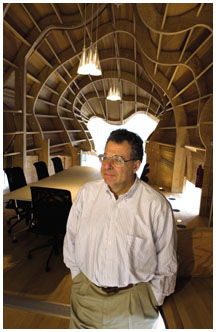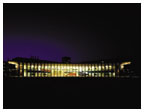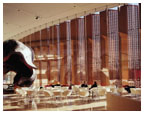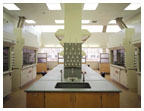April 20, 2005: Features
Have an opinion about this issue of PAW? Please take a minute to click here and fill out our online questionnaire. It’s an easy way to let the editors know what you like and dislike, and how you think PAW might do better. (All responses will be kept anonymous.) |
David Botstein, director of Princeton’s Lewis-Sigler Institute for Integrative Genomics, in a conference room designed inside a sculpture by architect Frank Gehry. (Jon Roemer) |
David
Botstein’s new biology
The head of Princeton’s young genomics institute
is pioneering a science curriculum that is gaining national attention
By Kenneth H. Chang ’87
Shirley Tilghman admits that she was taken slightly aback when she answered the phone nine months after becoming Princeton’s president four years ago. On the line was David Botstein, head of a top research lab at Stanford University and a pioneer of the Human Genome Project.
“He said, ‘I hear your job is open,’” Tilghman recalls. She thought rumors were swirling that her presidential reign was in trouble.
“Not unless there’s something I don’t know about,” the president replied.
“No, no, no, your old job,” said Botstein, referring to her vacated position as director of Princeton’s Lewis-Sigler Institute for Integrative Genomics, which studies how genes function together. He wanted to apply.
Tilghman asked why a man who led a laboratory of 30 scientists working on cutting-edge cancer research would want to come to a relatively new venture — it was then only three years old — and was impressed by his response: “Because I think we have to teach biology completely differently in the 21st century, and Princeton is the only place that is going to take me seriously.”
He got the job.
Biology was once a science mostly of observation and description, relying on persistence in arduous experiments that produced a morsel of knowledge. Genetics researchers labored for years to pin the location of a single gene. But today, with the genetic code fully unraveled for numerous creatures, from viruses to yeast to mice to people, biologists have, in essence, the lists of parts that make up the organisms, and they’re looking to deduce the operating manuals. Sequencing of entire genomes is performed en masse by machines, and the challenge is how to analyze the avalanche of data that pours out. Tracking the on-and-off switching of thousands of genes is as daunting as tracking inventory across thousands of Wal-Marts.
The Rafael Viñoly-designed Carl Icahn Laboratory, home of the genomics institute, contains 31 vertical louvers that increase energy efficiency and, through their shadows in the atrium, recall the double helix in DNA. (Ramon Vinoly)
The Icahn Lab atrium, with a conference area designed by Frank Gehry, at left, was meant to encourage conversation and collaborations among scholars in different disciplines.
Viñoly’s building design includes lab spaces that can be taken apart and rearranged to adapt to new developments and to promote collaborations among researchers. (Photographs by Ramon Vinoly) |
And so Botstein’s small institute has a grand ambition: understanding how all the pieces of biology that have been discovered in recent decades fit together into a functioning machine.
“Biology is fundamentally changed in the last five years,” Tilghman says. “There’s now an opportunity to ask entirely new questions that could not be asked before.” These new questions include those being asked, for example, by Professor John Hopfield, a physicist-turned-molecular-biologist who is using a computer science approach to explore how neurons code and compute information; and by physics professor William Bialek, who is working to understand the complex patterns in nerve signals.
The “new” biology requires top quantitative skills as well as an understanding of other sciences. At Princeton, one result is a new, yearlong curriculum that is, Botstein says, “unlike anything taught anywhere to undergraduates.” He believes that a mix of chemistry, physics, computer science, and even mathematics needs to be added to biology education — so much that the new Princeton curriculum will provide a good foundation for students majoring in those fields as well, he says. The new, full-year course has an unwieldy identifier — CHM/COS/ MOL/PHY 231-4 — that reflects the contributing departments: chemistry, computer science, molecular biology, and physics. The name of the course also does not roll off the tongue: An Integrated, Quantitative Introduction to the Natural Sciences.
The weekly time commitment is large enough — five hours of lectures, a three-hour laboratory, a three-hour computational laboratory, and an optional evening problem session — that it counts for double credits. Teaching the classes are two molecular biologists, two chemists, two physicists, and two computer scientists. “It’s like Noah’s ark,” Botstein says.
At 62, his bushy hair turning gray, Botstein has been one of the pioneers in genetics, and he wants to train the next generation. “I’m not going to be in this business for that much longer,” he says, “and this seemed like a great last big effort.”
The scope of the curriculum reflects Botstein’s own eclectic education, which, he admits, “had almost no biology in it.” An immigrant from Switzerland — his family moved to New York after World War II when he was 7 — Botstein graduated from the high-powered Bronx High School of Science, then, in 1959, headed to Harvard. He briefly considered a musical path, like that followed by brother Leon, now president of Bard College and music director of the American Symphony Orchestra, but he decided on science, planning to study physics.
Physics, however, was too crowded. Botstein found others to be better at the mathematics — “I wasn’t really competitive as a theoretiker,” he says — so he shifted more to the experimental side, helping to build instruments for high-energy physics experiments. “I was headed for being a modest-sized cog in a very large machine involving hundreds of physicists,” he says. Biology, on the other hand, was still something that a single scientist could explore. “I could do an experiment in the morning and interpret it the next day or even that evening,” he says. “The comparison didn’t stand up. In biology I could do everything myself, and it was all fun.”
His undergraduate course load consisted of heapings of physical chemistry and physics and only a single biology lab class. But biology already had begun to change and Botstein found himself, in time and place, ahead of the curve.
In 1956, James Watson arrived at Harvard as a professor, three years after he and Francis Crick deduced that a spiraling staircase of a molecule – deoxyribonucleic acid, or DNA – provided the blueprint for every living organism. Though the alphabet used in DNA consists of only four “letters,” variations in the sequence of letters produce thousands of proteins.
Watson, Botstein recalls, “was making the argument that biology was going to change, that it was going to become molecular, and that the issues of interest were the issues of information transfer from the DNA, which was obviously the information carrier, to the proteins, which were obviously doing the work in the cell. That was obvious to him, then. It wasn’t so obvious to everyone else. But he converted a bunch of young people to his point of view, and I was among them. In fact, it was physicists who were among the first converts.”
Botstein received a bachelor’s degree in biochemical sciences at Harvard and then a Ph.D. in genetics at the University of Michigan. He taught for 20 years at MIT, working primarily on the genetics of yeast. Then he moved to private industry and became vice president at Genentech for two years, before returning to academia at Stanford.
Along the way, he pulled a host of people into the field, including Eric S. Lander ’78. Lander, now director of the Broad Institute for Genomic Research in Cambridge, Mass., recalls a colleague introducing him to Botstein in 1985 as “this mathematician learning genetics.”
At the time, Lander, who majored in math, was on leave from a professorship at Harvard Business School to follow an interest in biology. A “mathematician learning genetics” turned out to be exactly what Botstein was looking for. “David immediately launched into some wonderfully bombastic Botsteinian discourse about what the challenges would be,” Lander recalls.
Lander started working with Botstein the next day, and within a couple of months they had worked out the mathematics needed to keep track of so many genes, so that they would not be awash in data. “It was David who sucked me into what became the Human Genome Project,” the massive project to read the entire sequence of 3 billion letters in a strand of human DNA and identify the 20,000 to 25,000 genes embedded in it, Lander says.
Botstein also came up with a crucial insight that provided the underpinnings of the genome project. Lander explains that, at a conference in 1978 — he was not present but has heard the story many times — genetics researchers were discussing a particular genetic disease and how they might be able to determine whether it was a dominant gene or a recessive one, and how hard it was to zoom in on it. Botstein blurted out, “Well, all you really need is a nearby genetic marker.”
Botstein, working on yeast, had figured out how to find markers, almost like signposts, in the yeast genome. From these, geneticists could construct a general map of the genome that would help them locate genes.
When others were still thinking one gene at a time, Botstein already had foreseen how an advance in yeast genetics could be applied to people, producing a genome-wide map that could be used for disease research. “That insight comes to him in a moment,” says Daphne Preuss, a former graduate student of Botstein’s who is now a professor at the University of Chicago. “It shows going from here to there in a big jump.”
Two years ago, Botstein was at Stanford, where his renowned lab helped to develop “gene chips” — slides on which pieces of DNA are affixed – that can be used to identify different subtypes of cancer, and that could lead to better diagnoses and help doctors tailor more effective treatments. He had hooked up with Patrick Brown, a Stanford biochemistry professor who had originated a simple way to make the chips, known more technically as microarrays. With the sequencing of full genomes, scientists can now place a sample of each of thousands of genes of an organism (a gene is just a section of DNA that provides the blueprint to build a protein) on a glass slide. They then can compare the behavior of genes in a normal cell (which they tag with a green dye) with those that have been stressed with heat or that have become cancerous (tagged red). The cells are broken up and their genetic material is placed on the slide. Some of the locations light up, indicating which genes are active in the cells. The green and red hues tell whether the functions are normal or unusual. By seeing which genes switch on and off in unison, scientists also can identify new genes that are involved in a process.
For example, using these gene chips, Botstein and Brown have identified four types of breast cancer that differ in their genetic makeup, something that never would have been learned from just looking at the tumors.
That makes a crucial difference for a drug like Herceptin, developed by Genentech. When evaluated against all four types, the data make the drug look useless, but it has been shown to extend the lives of women with one breast cancer type. In the overall test data, the benefit was washed out by the ineffectiveness among the larger group and it became apparent only when researchers could focus in on the smaller group.
Botstein says he does not miss this research, left behind in California. He says he does miss the weather.
To understand the challenge of getting students up to speed in this accelerating revolution in biology, consider a lab session last fall in the basement of Princeton’s Carl Icahn Laboratory. The experiment used nothing that was alive or ever had been alive — save for the students and instructors.
One day, 20 freshmen dropped tiny aluminum ball bearings into cylinders filled with glycerin, a clear liquid as thick as honey. They captured the slow fall of the bearings with a video camera and plotted the motion on a computer, all to measure the force of gravity. A few weeks later, they would build simple electronic light sensors, and learn the Java computer programming language. At times it seemed like a physics or engineering class, but it may be the future of biology education.
The ball-bearings-in-glycerin experiment teaches the same thing as rolling balls down inclined planes, a standard experiment conducted in freshman physics classes to demonstrate the acceleration of gravity. In this lab, however, the instructors also wanted to give students the experience of measuring forces of something moving within a liquid. The action of life happens within cells that, after all, are bags of water.
“We’re trying to build some intuition about physics concepts that aren’t so intuitive,” says institute researcher William Ryu ’94, one of the designers of the lab. At the same time, he says, they try to “add a biological flavor.”
To measure the speed of the falling ball bearings, the students first used rulers and stopwatches, just as in a typical physics class. But then they switched to the video cameras and used the computers to plot and calculate the velocity. In a later class, the students would measure the growth of bacteria colonies. But instead of looking through a microscope to count the colonies one by one, students shined a light through the dish and measured how much light was blocked: the more bacteria, the less light passing through. Ryu designed the simple light meter that the students built as part of the experiment. “Ancient principles with modern equipment,” says Botstein, summing up the underlying philosophy.
To some, the high-tech equipment is a shortcut that diminishes the students’ understanding of the underlying biology; in a way, the debate is a high-end version of the argument over whether calculators should be allowed in math classes in elementary schools. Botstein forcefully comes down on the side of the computers and calls the withholding of such tools from students “hazing.”
“We think we can teach a lot more that’s useful ... if we don’t have to calculate everything in our heads,” he says. “If you want to ask whether Euler or Newton or Gauss would have liked the computer, there is no question. They wasted endless amounts of time calculating things. ...Why are we teaching our students to do without those things? Do we think there’s going to be a future with no electricity, no computers?”
In Princeton’s curriculum, students are given a unified picture, instead of different aspects of the same topic. In discussing atoms, for example, a professor in a typical chemistry class might focus on how the electron orbits interact as different atoms bond together, while a physics professor might only discuss hydrogen, the simplest atom, and explain all its quantum nuances. But rarely would students learn how the two approaches come together. Similarly, in teaching statistics, most classes begin with the flipping of coins. In the new course, the instructors, teaching the same concepts, used a biological example: genes. “It makes it vivid, concrete,” says Lubert Stryer of Stanford University, who chaired a National Academies of Science committee that a couple of years ago criticized the typical college biology curriculum as inadequate, and who visited the new Princeton class recently. “There you can see the role of chance in generating diversity. That was wonderful. They start probability with [father of genetics Gregor] Mendel and not with flipping coins.”
Stryer says the new curriculum shows students how to move from the tremendous volume of raw data to the “biological insight,” explaining, “We need to educate men and women who ... have an intuitive feeling for quantitative thinking.” After his visit to Princeton, he described the new curriculum as “something really novel and very much in line” with what the NAS committee had hoped for.
Botstein hopes that the new curriculum — and the institute itself — will produce physicists and chemists who can talk to biologists, and vice versa. Both the physical design of the Icahn Lab, which houses the institute, and its scholarly agenda were designed to promote the collaborations Botstein envisioned, with faculty members drawn from across Princeton’s science and engineering departments. Architect Rafael Viñoly planned the lab to have large blocks of lab and office space that can support any kind of work, and offices for scholars doing computational research are sprinkled among those for researchers working on bench-top experiments.
Last year, the National Institute of General Medical Sciences, part of the National Institutes of Health, established a new center at Princeton — with Botstein as its director — to use advanced computational methods to explore how biological molecules interact with each other and their environment to create new systems. The new center, which came with an immediate grant of $3 million and a total pledge of almost $15 million over five years, relies heavily on Botstein’s integrated, multidisciplinary approach.
How to measure success? Botstein says there is no easy measure. He hopes a large fraction of the 38 students in the new course will go on to graduate school. (At present, more than two-thirds of Princeton’s physics majors and 10 to 15 percent of its molecular biology majors continue in academic science, though other students attend medical school.)
“If we increase the number of students who are motivated to become professional scientists, we will regard that as a big success,” he says. “We will have added nontrivially to the number of American scientists. Whereas science is becoming a larger and larger fraction of our culture and economy, a smaller and smaller fraction of those who are arguably the best students in the world are going into it.”
But he adds, “I’m not going to know that for a long time.”
![]()
Kenneth H. Chang ’87 reports on science for the New York Times.





